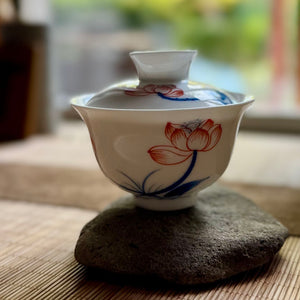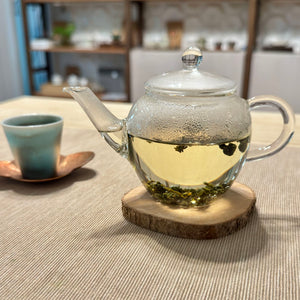How to make tea in a clay teapot
How to make tea in a clay teapot
In this guide, we'll show you how to make oolong tea in a clay teapot, using Oriental Beauty rolled leaf oolong. Clay teapots are great at retaining heat and will absorb the flavor of the tea over time, making subsequent brews even more delicious.
Loose leaf teas (e.g. Oriental Beauty or Jade Rouge) steep faster than rolled leaf teas (e.g. Frozen Summit), so the steeping time should be 1 minute rather than 2. At our recommended ratio (6 grams of tea to 2.4 dl of water), we recommend 3 infusions with the same tea, but you can of course adjust to your own taste. We recommend that you do all infusions the same day.
Video guide
Step by Step - A Guide to Using a Clay Teapot
Step 1: Weigh the tea leaves
Measure out 6 grams of oolong tea. It is important to use a scale because the size and shape of the leaves can vary – this will ensure that you always get the right amount into the pot.
Step 2: Rinse and preheat the clay pot
Rinse the kettle with hot water (approx. 90–100 °C). We will use the same water temperature to brew the tea. A preheated kettle helps to make the brewing more precise and balanced. Always check the recommended temperature for each tea – the information provided with your tea can be a guide.
Step 3: Put the tea in the pot
Pour out the heating water and then place the oolong tea leaves in the preheated pot. The warm pot helps to release the scent and aroma of the leaves.
Step 4: Rinse the tea
A quick rinse with hot water will remove any dust particles left on the surface of the leaves and help preheat them so they maintain the right temperature during soaking.
Step 5: Pour in water
Pour the water in a circular motion around the edge of the pot, so that the leaves start to move nicely and are evenly moistened. If necessary, you can gently rotate the pot. As a general rule, a lower water temperature (about 90–95 °C) is ideal for twisted-leaf oolong, while a higher water temperature (100 °C) is ideal for tightly rolled types – this helps the right flavors to develop.
Step 6: Let the tea steep
Steep the tea for 1 minute. For more tightly rolled leaves, 2 minutes is recommended to allow them to unwind nicely and release their full flavor.
Step 7: Pour into a jug
Once the steeping time is up, pour the tea into a jug or cup. It is important to pour out all the liquid to avoid the tea leaves from over-fermenting and giving a bitter taste to subsequent brews. If you want to be on the safe side, use a fine strainer.
Step 8: Fill and enjoy
Pour it into a cup and enjoy your freshly brewed oolong tea!
Step 9: Further Pourings - 'Re-soaking'
The tea leaves can be steeped again – we generally recommend three brews with this tea-to-water ratio. For the second brew, we recommend the same amount of time as the first, while for the third brew, we recommend 1-2 minutes longer. Each new steeping brings out different flavors – these are what make the world of oolong teas truly exciting.
Frequently Asked Questions – Making Tea in a Clay Teapot
What kind of tea is worth making in a clay pot?
We recommend using a clay pot primarily for aged or roasted teas. The porous structure of clay helps preserve the aromas of the tea and provides a deeper taste experience. It is worth avoiding heavily scented teas, as these can leave a lasting mark on the pot.
Should I use a separate pot for different teas?
Serious tea lovers – including us – recommend that if you are making very different types of tea, it may be worth using a separate clay pot for each. For example, one for oolong, one for green tea, etc. This will avoid mixing flavors.
Should the new clay pot be consecrated?
Initiating a new kanna is not mandatory, but many people find it useful. Over time, with regular use, the kanna will “self-absorb” the aroma of the tea anyway. If you would like to learn more about kanna care and initiation, we have prepared a separate guide on this.

Making tea in a Gaiwan
Brewing tea in a gaiwan is one of the most elegant and ancient forms of Chinese tea culture. This method allows us to discover new layers of flavor in the tea with each pour.
Making tea in a clay teapot
Brewing tea in a clay teapot adds a special depth and roundness to the drink, especially for oolong, puer or black teas. This traditional method enriches not only the tea, but also the tea-drinking experience.
Making cold brew tea
Cold brew tea is a refreshing, smooth and naturally sweet alternative to hot water brews. It's easy to make and ideal for summer days or on the go.

Making tea using a French press
A French press is a great tool not only for coffee but also for tea – fast, convenient and surprisingly efficient. It is the ideal choice for those who simply want to get the most out of their loose teas.


